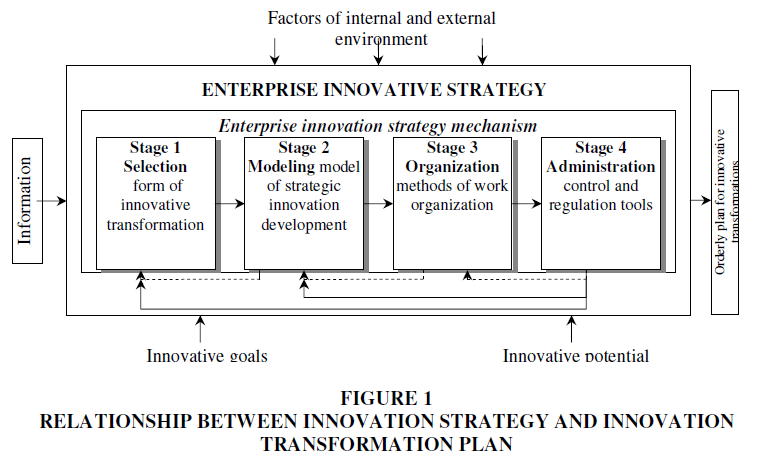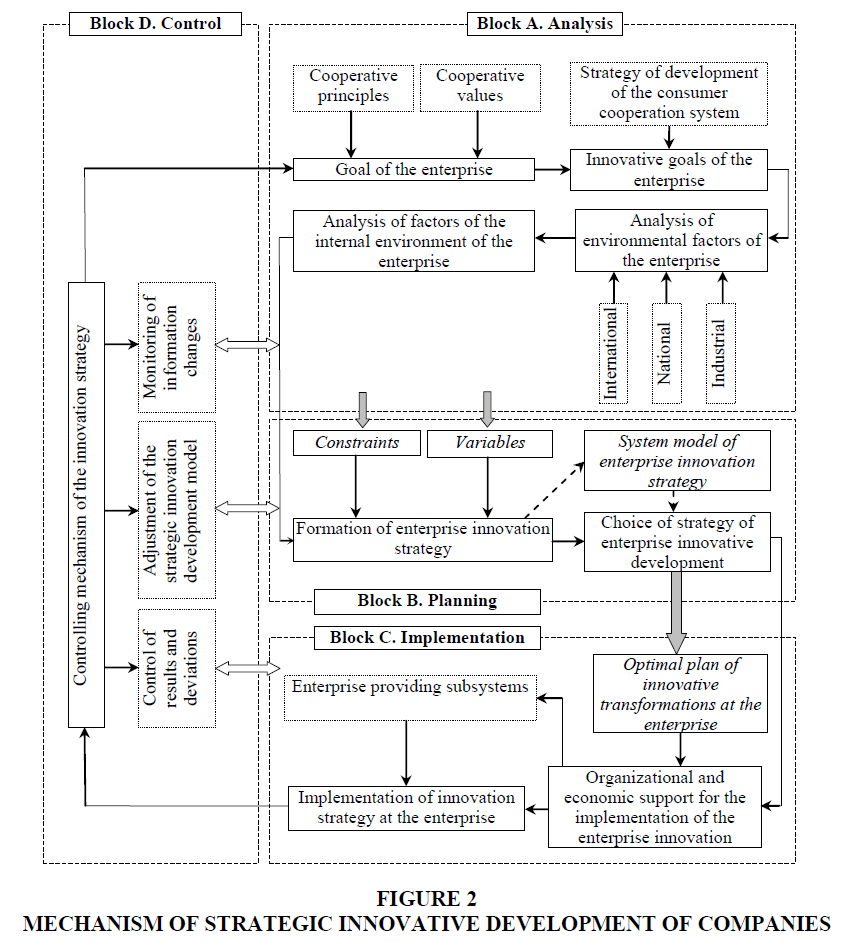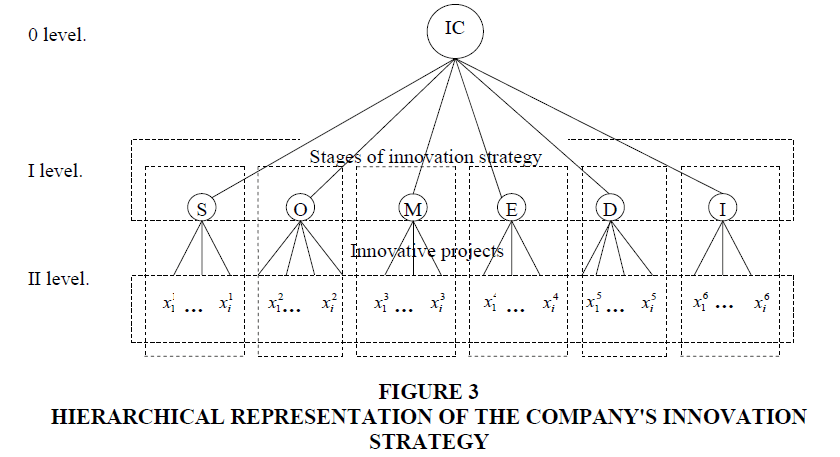Research Article: 2020 Vol: 19 Issue: 4
Strategic Management Mechanism of Innovative Development of Industrial Companies
Olga Afanasieva, Moscow Aviation Institute (National Research University)
Olena Volska, SHEE "Kherson State Agrarian University"
Khavakhon Rakhimova, WorkPlace Banking and Finance Academy of the Republic of Uzbekistan
Victor Yemtsev, National University of Food Technologies
Victoria Matveeva, Don State Technical University
Abstract
The article describes in detail the components and functional elements of the strategic management mechanism of the innovative development of companies. The stages of structural transformations and the implementation of the model of innovative development are also characterized. The fundamental differences in strategic management of the effectiveness of the introduction of basic and improving innovations are highlighted. Active models of the formation of the mechanism of strategic innovative development of the company are substantiated.
Keywords
Strategic Management Mechanism, Mechanism Structure, Innovative Type of Development, Basic and Improving Innovations, Vector of Innovative Transformations.
Introduction
A necessary condition for the effective functioning of companies is the development of fundamentally new development models, which are founded on a harmonious combination of current production activities with the possibilities of future economic development based on advanced engineering and technology, the introduction of the latest company management systems, an integrated approach to the development and implementation of innovations, assurance of the progressive innovative changes and reorientation to an innovative type of development. It is strategic planning in the field of innovation that is the main element in increasing the efficiency of a company in the market conditions. In such conditions, the development of an industrial company must be ensured by forming an effective mechanism for innovative development.
Literature Review
The effectiveness of the formation of the mechanism of strategic innovative development is determined by the principles underlying its construction. The construction of any rational mechanism within the framework of the business entity should be based on the principles established in the works (Arogyaswamy & Koziol, 2005; Hamel, 2008; Drobyazko et al., 2019). Issues of innovative development of companies and the formation of the development strategy are presented in various scientific forms in the publications of such scientists (Christensen, 2003; Folta & Janney, 2004; Drobyazko et. al., 2020). The problems of increasing the innovative activity of companies, sources of its investment, and financial incentive levers are quite complex and multifaceted. Their solution is dedicated to the works of such scientists as (Drucker, 2006; Koivisto, 2005; De Wit & Meyer, 2010). Despite the significant contribution of scientists to the formation of the theoretical and methodological foundations of innovative aspects of companies, the studies did not adequately reflect issues related to the specifics of strategic management of innovative activities.
Methodology
As a methodological platform for our research, the following approaches and theoretical models are used: 1) resource approach that makes it possible to carry out the innovative development of the company in the best way; 2) quantitative assessment that allows assessing the company's need for innovative development, as well as the results from the implementation of this mechanism; 3) the model of potential formation, which allows comprehensively assessing the innovative potential of the company; 4) integrated approach to the study, according to which the mechanism of innovative development should be understood as a set (complex) of interrelated elements that allow regulating and stimulating a sequence of ordered and irreversible changes within the company by means of targeted transformations of an innovative nature in various areas of its activity; 5) obtaining the research result is the achievement of such a level of innovative development that will allow the company carrying out its activities in the external environment in a better way compared to competitors in terms of indicators that are significant in current and forecasted market situations.
Findings and Discussion
Studying the process of forming the structure of the company’s strategic innovative development mechanism in accordance with the stages of the innovation strategy, it should be noted that it focuses on the following main tasks: substantiation of the basis for innovative growth of the company, ensuring the continuity of the introduction of innovative changes and their support within the company (organizational, technical, financial and so on), and control and analysis of the feasibility of introduced innovations in connection with a change in the level of competitiveness of the company (Makedon et al., 2019) (Figure 1).
Stage 1
Determination of the vector of structural transformations, the desired structural type from a number of alternatives and its corresponding purposes. At this stage, the forms of future innovative transformations are outlined, the priorities of alternative flows are generated and determined, the resources needed to realize each of the possible options are evaluated, and their availability is analyzed.
Stage 2
Modeling of development strategy and structural transformation. This stage will correspond to the choice of a model of strategic innovative development with the subsequent identification of variables, mutual relations between them, and the definition of functions and structure of the system.
Stage 3
Specification of ways of realization of the company’s innovative strategy taking into account specificity and competitive advantages. The methods of organization of works from the formulation of the idea to the achievement of the commercial result are determined. At this stage, the planned and selected innovation goals are considered as innovative projects with a certain amount of resources to ensure them and require organizational support, taking into account the time factor.
Stage 4
Formation of a system of levers, methods, instruments of regulation and control, which will ensure in the future continuous implementation of the program of innovative transformations depending on the chosen model of strategic innovative development of the company (Gallivan, 2011). The fundamental differences in managing the effectiveness of the implementation of basic and improving innovations, which are highlighted and systematized in Table 1, are defined.
| Table 1 Fundamental Differences in the Strategic Management of the Effectiveness of the Implementation of Basic and Improving Innovations | ||
| Controls | Innovations | |
| Basic | Improving | |
| Strategic - basic functional strategies | Leader strategies (offensive) - research leadership - leading knowledge-based - stage-by-stage overcoming of the life cycle | Follower strategies (protective) - licensed - technological transfer - waiting for the leader - following the market |
| Production process - main functions | Management of research and exploration | Innovation management |
| R&D is the primary form of protection | Creation of technologies on the basis of fundamentally new results of basic research. Conducting applied research - legal and economic methods | Improving existing production capabilities based on already known scientific and technical standards - economic methods |
Since the content of strategic management of innovative development is to some extent unique to each company and characterized by its specific form dictated by factors of the internal and external environment (Florida, 2002), the features of the strategic innovation development mechanism in accordance with the logic of strategic management and systematic approach are detailed. They can be schematically represented as a set of 4 blocks (Figure 2): analysis, planning, implementation, and control.
Block A
Analysis. As an integral part of the strategic innovation development mechanism, the analysis block is primarily an information and analytical one whose task is to consistently analyze and prepare input data in the form of variables and constraints that will be used to build the innovation strategy model stage. At the same time, the identification of external factors is best carried out according to the principle – maximum use of the strengths of the company to ensure its advantages over competitors, factors of the internal environment - maximum use of the internal reserves of the company and the consistent elimination of weaknesses, which are the most “bottleneck” in achieving the goal (Hayati, 2017).
The detailed study of the main factors influencing the choice of innovation strategy, both internal and external, reflecting the strengths and weaknesses of the company and its competitors, will allow better thinking about the company's innovation strategy. Considering them and, accordingly, adjusting the company’s innovation model strategy create opportunities to increase the mobility and adaptability of the company to the changing conditions of the internal and external environment.
Block B
Planning. The task of planning is to study on the basis of input data of alternative ways of innovative development in accordance with the set of proposed variables and constraints and formulate a model of innovation strategy, which on the one hand satisfies the vision of the management of the company’s strategic innovation development, and on the other reflects the real state of internal resource systems and external market needs.
The strategy of innovative development is possible due to the development of a system model, focused primarily on the intensification of internal capacity, taking into account the peculiarities of the company. This is a systematic approach, taking into account the multi-sectoral nature but at the same time organizational and functional integrity, that will allow obtaining synergistic effect through the use of cross-sectoral interactions.
Block C
Implementation. Innovation strategy as a vector of innovative development of a company is restructured in the form of a set of stages of a complex dynamic system reorganization, each of which is a generic goal of a certain subset of innovative goals. Therefore, the innovation strategy in the system view is a multilevel hierarchical structure with the existing links between its structural elements - the innovation goals and stages, which in combination describe the process of forming alternative options for innovative development of the company and the choice among them the innovative strategy that optimally satisfies existing needs and constraints (Prajogo, 2016).
Therefore, the formation of a model within the strategic innovation development mechanism for companies should be carried out taking into account the following principles.
1. Self-organization. The innovation model is based on interaction, interconnected subsystems, taking into account the complex structure of the company, based on the functioning of subsystems of production, finance, marketing, and management, where the innovative development of the company is more than just the sum of the innovative results of its individual elements.
2. Closureness within the system. The organization of innovative processes in the company should be reflected in the model of different connections between the elements of the system.
3. Social and economic focus of innovation. The introduction of innovation is not an end in itself but the essence of the model is determined by the combination of social and economic aspects of innovation development, and therefore the goals of innovation will be socially oriented.
4. Variability. In the process of modeling the innovation activity, the idea of priority remains and the possibility of constructing individual strategies of innovative development depending on the fluctuations of the external and internal environment is taken into account.
The whole process of providing the model of the company’s innovation strategy, taking into account existing interconnections, can be schematically depicted in the form of a multilevel construction of interdependent elements integrated into different subsystems (Figure 3).
The goals of the first level are generalized, reflecting the general goal of the elements of the second level, which, without simply summing up the goals of the second level, is a decomposition of the zero level in the form of a set of stages of the innovation strategy. Optimization of the goal function of the first level leads to the formation of the structure of the innovative strategy.
The second level of the innovation strategy model is a detailed presentation of all planned innovative goals selected by the expert method as the most effective, relevant, and resource-like to ensure the company’s innovative development (Corey et al., 2014). Optimization of the goal function of the second level allows effectively distributing available resources in accordance with the priority of innovative goals, and therefore, requires a preliminary determination of the value of priority, that is, it comes down to building two models - a model that will determine the priority and a model that will optimize the existing resource potential.
Block D
Control. The coordination of the company’s strategic innovative development mechanism consists in coordinating information between the blocks of the mechanism, while according to the selected block, monitoring is provided for in the following areas: monitoring of results and deviations (block C. Implementation), adjustment of the model of strategic innovative development of deviations (block B. Planning), and monitoring of the information changes (block A. Analysis).
Thus, the company’s strategic innovative development mechanism should combine the following processes: determining the vector of innovative transformations, creating the strategic innovative development model, developing tools for monitoring and analyzing the results of implementing the innovative strategy.
Recommendations
In the future, the work of the company’s strategic innovative development mechanism should be focused on maintaining the balance between strategic priorities and perspective directions of innovative development of the company itself, minimizing economic risks through the construction of a flexible mechanism for controlling the implementation of innovative strategy at each stage, developing the dynamic strategies capable of responding to changes in external and internal factors. The use of the proposed mechanism of strategic innovation development to the formation of the innovation strategy will allow, by directing the activity of the company in the direction of the strategically determined innovation development model, systematizing innovative transformations, organizing rational interaction of all internal elements of the system, and exercising control over innovations.
Conclusion
Since the innovative development is a purposeful, continuous process of innovations in scientific, industrial, economic, commercial, financial, marketing, and management activities of the company, aimed at the fullest satisfaction of social needs based on the implementation of scientific achievements in the production process to maximize economic impact, expressed in change of economic indicators, the company innovative development management should be carried out on the basis of methods and means of influence on innovation or processes by creating an effective mechanism innovation. The proposed model of the company innovative development mechanism is aimed at activation of the innovative potential of the company and its transformation into innovative capital in the conditions of development of the company interaction integration processes.
References
- Arogyaswamy, B., & Koziol, W. (2005). Technology strategy and sustained growth: Poland in the European Union. Technology in Society, 27(4), 453-470.
- Christensen, C.M. (2003). The innovation’s solution. Boston: Harvard Business School Press.
- Corey, K.E., Wilson, M.I., & Fan, P. (2014). Cities, technology, and economic change. Cities and economic change. Sage Publications Ltd.
- De Wit, B., & Meyer, R. (2010). Strategy synthesis: Resolving strategy paradoxes to create competitive advantage. Cengage Learning EMEA.
- Drobyazko, S., Bondarevska, O., Klymenko, D., Pletenetska, S., & Pylypenko, O. (2019). Model for forming of optimal credit portfolio of commercial bank. Journal of Management Information and Decision Sciences, 22(4), 501.
- Drobyazko, S., Vinichenko, O., Chayka, Y., Nechyporuk, N., & Khasanov, B. (2020). Increasing efficiency of entrepreneurial potential in service sector. Journal of Entrepreneurship Education, 23(S1).
- Drucker, P.F. (1996). The executive in action: Managing for results, innovation and entrepreneurship, the effective executive.
- Florida, R. (2004). The rise of the creative class and how it’s transforming work, leisure, community and everyday life (Paperback Ed.). GEN, New York: Basic Books.
- Folta, T.B., & Janney, J.J. (2004). Strategic benefits to firms issuing private equity placements. Strategic Management Journal, 25(3), 223-242.
- Gallivan, M.J. (2001). Organizational adoption and assimilation of complex technological innovations: development and application of a new framework. ACM SIGMIS Database: the DATABASE for Advances in Information Systems, 32(3), 51-85.
- Hamel, G. (2008). The future of management. Human Resource Management International Digest.
- Hayati, B.T. (2017). BPTT 3133 Technology Transfer in Business. Retrieved from http://www.slideshare.net/nabilahnajah/sem-5-tt-week-1?from_search=1
- Koivisto, T. (2005). Developing strategic innovation capability of enterprises. Theoretical and methodological outlines of intervention. Espoo: VTT Publications.(ProACT).
- Makedon, V., Valikov, V., Kurinnaya, I., & Koshlyak, E. (2019). Strategic innovative development of the enterprises: theory and methodology. Scientific Journal Economics and Finance, (2), 52-62.
- Prajogo, D.I. (2016). The strategic fit between innovation strategies and business environment in delivering business performance. International journal of production Economics, 171, 241-249.


